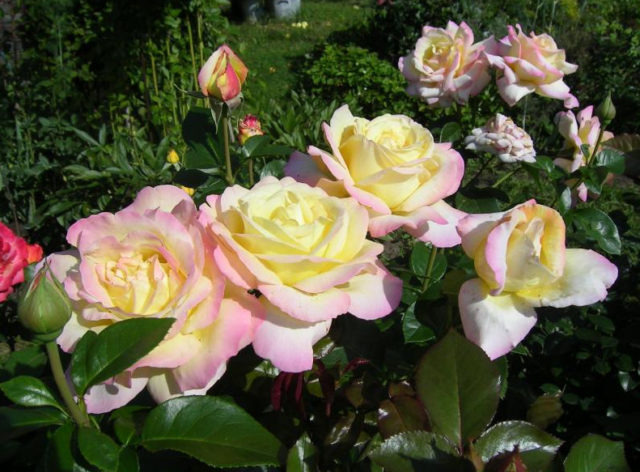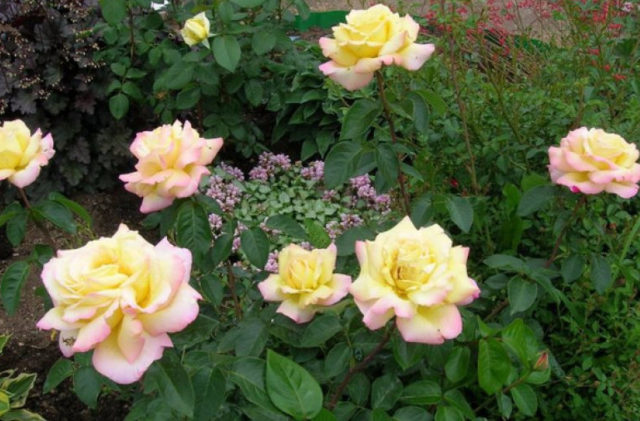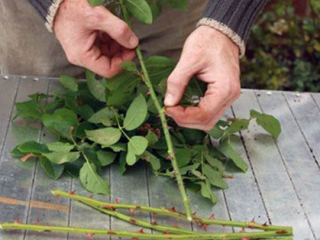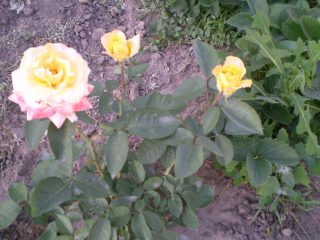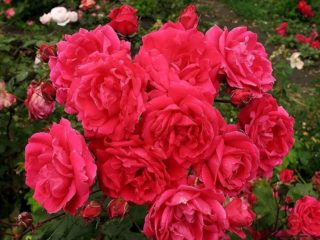Content
- 1 History of selection
- 2 Description and characteristics of the hybrid tea rose variety Gloria Day
- 3 Advantages and disadvantages of hybrid tea rose Gloria Dei
- 4 Reproduction methods
- 5 Planting and caring for rose Gloria Day
- 6 Pests and diseases
- 7 Climbing rose Gloria Day Climbing in landscape design
- 8 Conclusion
- 9 Reviews of hybrid tea rose Gloria Day Climbing
Among the huge variety of hybrid tea varieties, the Gloria Day rose stands out with its spectacular bright appearance. The combination of delicate shades of yellow and pink makes it recognizable among many others. The touching story of the creation of the variety is also of interest.
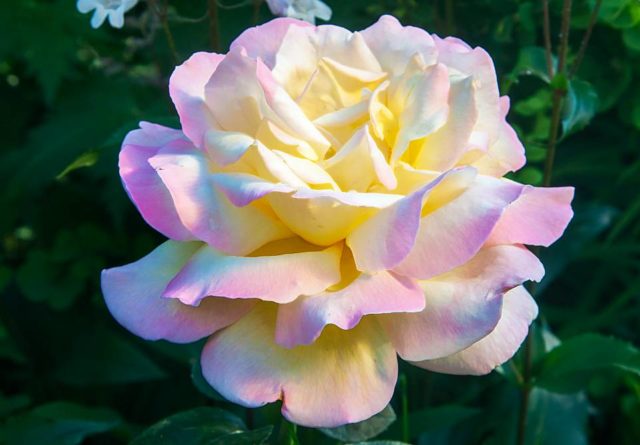
Rose "Gloria Day" is recommended to be planted in the area after legumes or asters
History of selection
The French nursery Meyland became the birthplace of the most famous variety, Gloria Dei. Gardener Joseph Rambaud, who had a special love for roses, gave birth to a business that became his life's work. It was continued by his daughter, son-in-law and grandson Francis. It was he who in 1935 grew 50 hybrids from seeds brought from the USA. Examining the newly blooming flowers, the young breeder noticed a pink and yellow specimen. Two of the three buds on the seedling died.From the third appeared the famous “Gloria Day”.
During this period, the plant did not yet have status or a registered name, but was extremely popular; it was sent from the nursery to many countries on orders from breeders and gardeners. The established ties were disrupted by the war that began in 1939 and swept across Europe. Roses were given their own names in different countries. In her homeland she was called “Madame Meilland” (Mine A. Meilland), the Italians gave her the name “Delight” (Gioia), in Germany - “Glory to the Lord” (Gloria Dei), in the USA - “Peace”. The rose was delivered to the USSR under the name “Gloria Day”.
She became a symbol of peace - she survived in harsh times, flowers were awarded at the UN Assembly in 1945. The variety often received awards at competitions and exhibitions.
Description and characteristics of the hybrid tea rose variety Gloria Day
The variety "Gloria Day" has peony-shaped flowers of a golden color with a pinkish tint. The diameter of the blossoming buds is up to 15 cm. Each of them contains about 35 petals, delicate, thin and slightly wavy. The saturation of their color depends on the lighting and climate. The aroma is pleasant, medium strength.
The plant forms a powerful semi-spreading bush from one meter and above. Shoots with thorns. The leaf plates are glossy, dense structure.
The video allows you to get acquainted with the rose “Gloria Day” in more detail:
Its flowering begins in July and lasts 2 weeks, after which a repeated, but more moderate budding is observed in early September. The plant belongs to zone 6 of frost resistance and tolerates temperatures down to -23 ⁰C.
The variety was entered into the state register in 1970 with a recommendation for use in all regions of the Russian Federation.
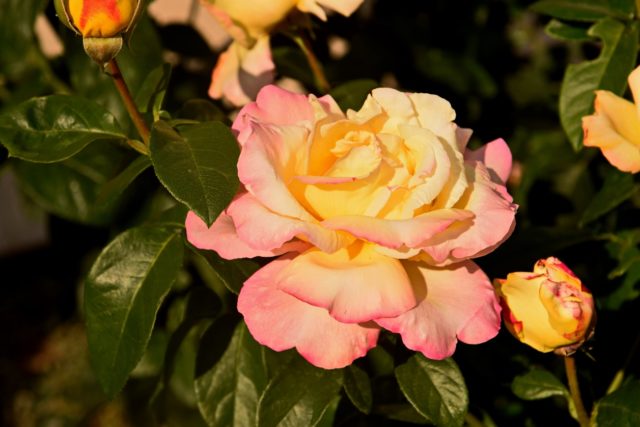
After autumn planting, the seedling is covered especially carefully for the winter.
Advantages and disadvantages of hybrid tea rose Gloria Dei
Despite the apparent tenderness of the flowers, the rose has the following advantages:
- it is resistant to a number of diseases and is affected by pathologies under extremely unfavorable weather conditions;
- undemanding in care;
- has frost resistance;
- successfully propagated by cuttings or grafting onto rose hips;
- has a spectacular color and flower shape;
- suitable for cutting;
- has a strong bush.
There are not many disadvantages of the Gloria Day rose:
- flowers can fade in the sun;
- after heavy rain, the buds sometimes do not open;
- late start of flowering.
Reproduction methods
For several decades now, the Gloria Day variety has remained in demand among amateur gardeners. In order to propagate a rose, you should purchase a ready-made seedling, and after it has rooted and grown, use it as a mother plant. The most effective methods are cuttings and grafting.
Propagation by cuttings
The method does not provide 100% rooting, but with a favorable outcome, a rooted plant is obtained. To do this, they follow the following algorithm:
- In cloudy weather, parts of semi-lignified shoots of medium diameter are cut.
- The tops are cut off and the stem is divided into parts 7-9 cm long.
- The upper cut on the cutting is made at an angle of 90⁰ above the bud, the lower cut is made obliquely under the bud.
- The leaves are shortened by half.
- The cuttings are placed in a solution of a root formation stimulator for 5 hours.
- They are planted in boxes with a moistened soil mixture of peat, sand and turf soil at an angle of 45⁰.
- Cover with film or plastic containers.
- A month later, the rooted cuttings are released from the shelter, the plants are grown and planted.
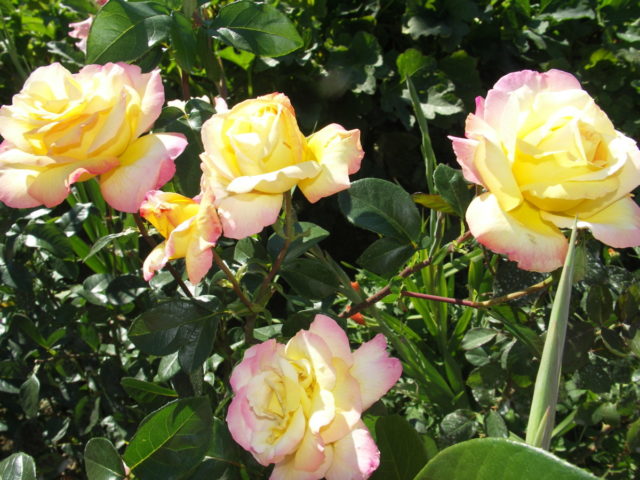
Roses are watered twice a week.
Reproduction by grafting
The method is to use rose hips as a rootstock for the Gloria Day rose. Graft with a bud or cuttings. In the first case, the bark is cut in a T-shape and a graft consisting of a rose bud and a piece of scutellum is inserted under it. After this, the rootstock is tightly wrapped with film, leaving the bud open. Within a month it will become noticeable that the kidney is developing. After complete engraftment of the scion, the film is removed.
Planting and caring for rose Gloria Day
The plant needs an area well lit by the sun, ventilated, but without drafts and northern winds. Preferred soil is neutral, air- and moisture-permeable, rich in organic matter.
For the Gloria Day rose, prepare spacious holes 50 cm deep and wide, placing them at a distance of 60-70 cm. Drainage is placed at the bottom, and humus is placed on top. The plant is placed in the center of the hole, its roots are straightened and covered with soil. After watering, the soil surface is mulched with peat, humus and leaves.
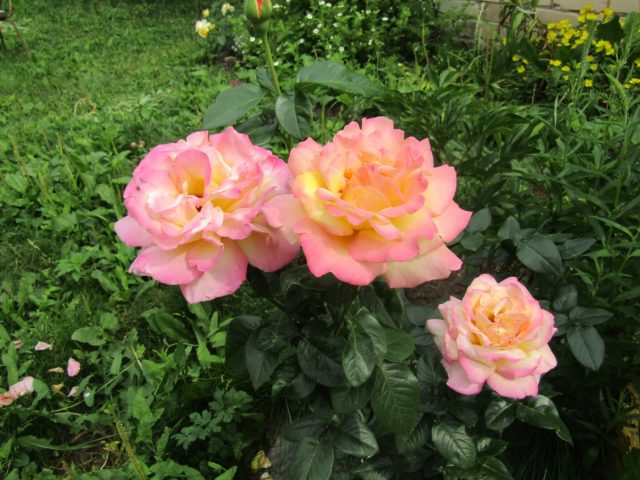
The rose bush "Gloria Day" grows up to 130 cm wide
Watering the seedling is carried out with warm water strictly “at the root”. Twice a month the soil near the plant is loosened to remove weeds. Fertilizing is carried out several times - in the spring, organic matter is added to the bush, after flowering - mineral complexes.
Pruning the Gloria Day rose for the purpose of rejuvenation is carried out in the fall, removing damaged and immature shoots.
In preparation for winter, the bushes are covered with spruce branches, sawdust, boxes or non-woven material.
Pests and diseases
The occurrence of diseases and damage to roses by insect pests is most often associated with low light, unfavorable weather conditions, dense plantings and insufficient ventilation. Plants located nearby can become a source of infection.
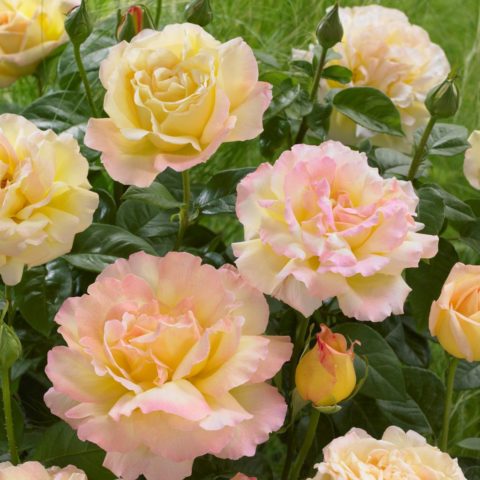
The aroma of the climbing rose "Gloria Day Climbing" intensifies after the rain
Powdery mildew
The occurrence of a fungal disease is signaled by the appearance of a white coating on the leaves, which turns brown over time. The rose stops developing, does not form buds, and later parts of the plant turn black and die.
To combat parasitic fungi, fungicides are used, and the affected parts of the plant are cut out and disposed of.
Black spot
The pathology is characterized by the appearance of round black spots on the top of the leaves and on the shoots. After some time, spores form in their place, the leaves turn yellow and fall off. Rose "Gloria Day" loses its decorative effect, the bushes are completely exposed. In the fight against black spot, copper sulfate preparations are used and plants are supported with immunostimulants.
Rust
On heavy and wet soils, roses often suffer from rust. At the beginning of summer, red spots appear on the back of the leaf blades, gradually turning black. The shoots darken and bend, the Gloria Day rose stops developing and stops blooming. To combat rust, preparations containing copper are used, and the affected foliage is collected and burned.
Pests
Pests can cause irreparable damage to a plant. The most common among them:
- spider mite;
- rose aphid;
- leaf roller;
- scale insect;
- slobbering pennice;
- bear
The use of insecticides and manual collection of insects are the main options for controlling them.
Climbing rose Gloria Day Climbing in landscape design
As a result of bud mutations, a climbing large-flowered hybrid “Gloria Day” appeared with the name “climbing”. It is distinguished by its strong growth, long shoots (up to 4 m), late, long flowering and large beautiful buds.
Rose "Gloria Dei Climbing" is successfully used for vertical gardening. Its yellow-pink flowers and decorative emerald leaves cover the entire plant from top to bottom. With its help they create arches, columns, decorate balconies and gazebos.
The rose goes well with other vines - lemongrass, grapes, and is effectively shaded by conifers and ferns. The climbing variety also looks impressive next to other species.
Conclusion
Tea rose "Gloria Day" from French breeders has long become a legend, gaining popularity all over the world. The bush and climbing species are still purchased from the Meilland nursery, receiving seedlings that can grow in one place for many years, bloom profusely and delight the eye with the splendor of blossoming buds.
Reviews of hybrid tea rose Gloria Day Climbing
Many gardeners note the unique characteristics and versatility of the Gloria Day Climbing rose in their reviews, descriptions and photos.
